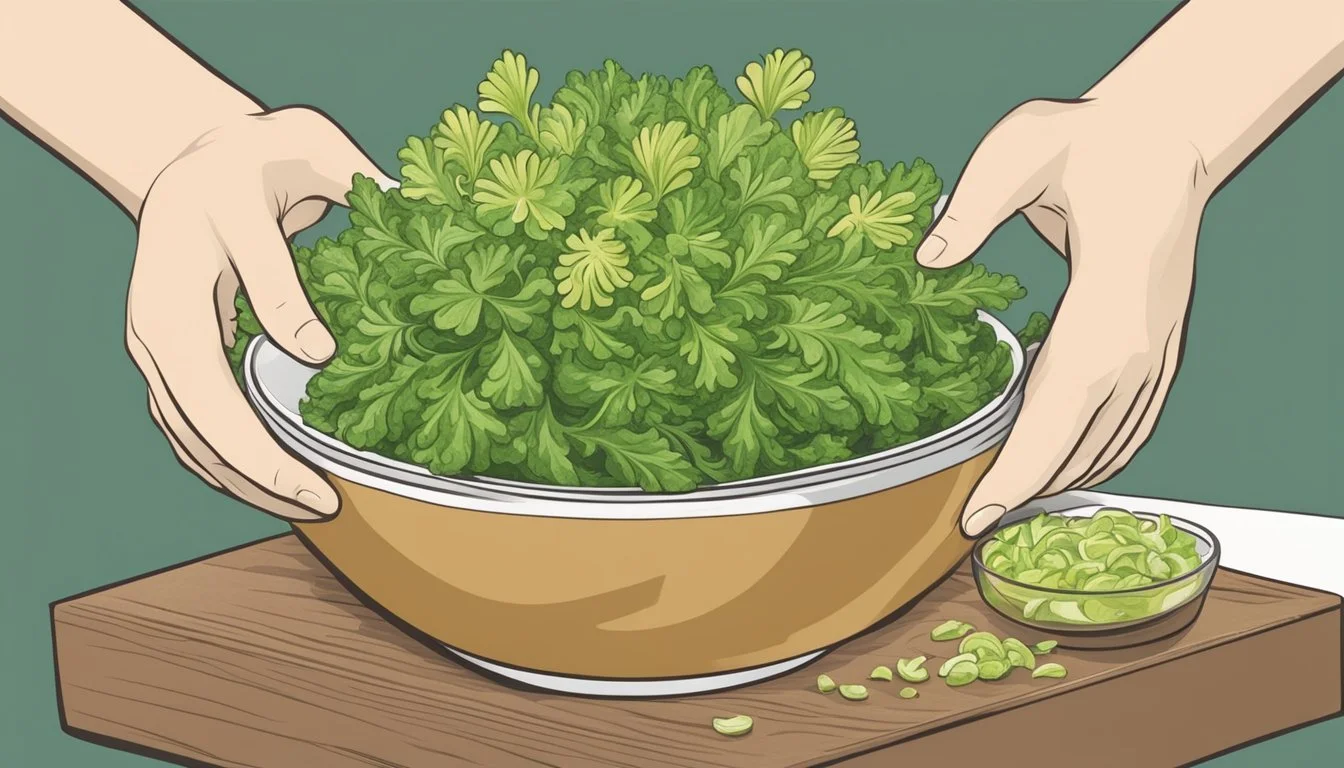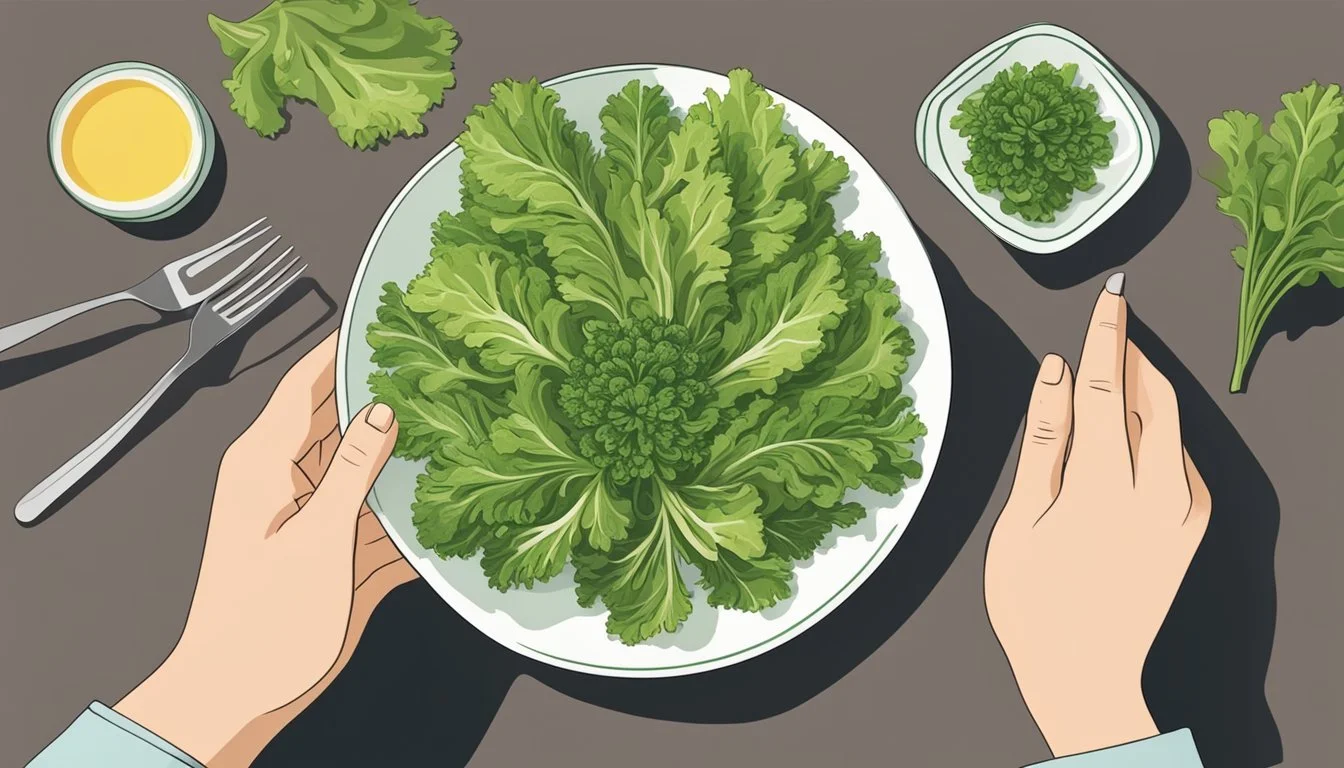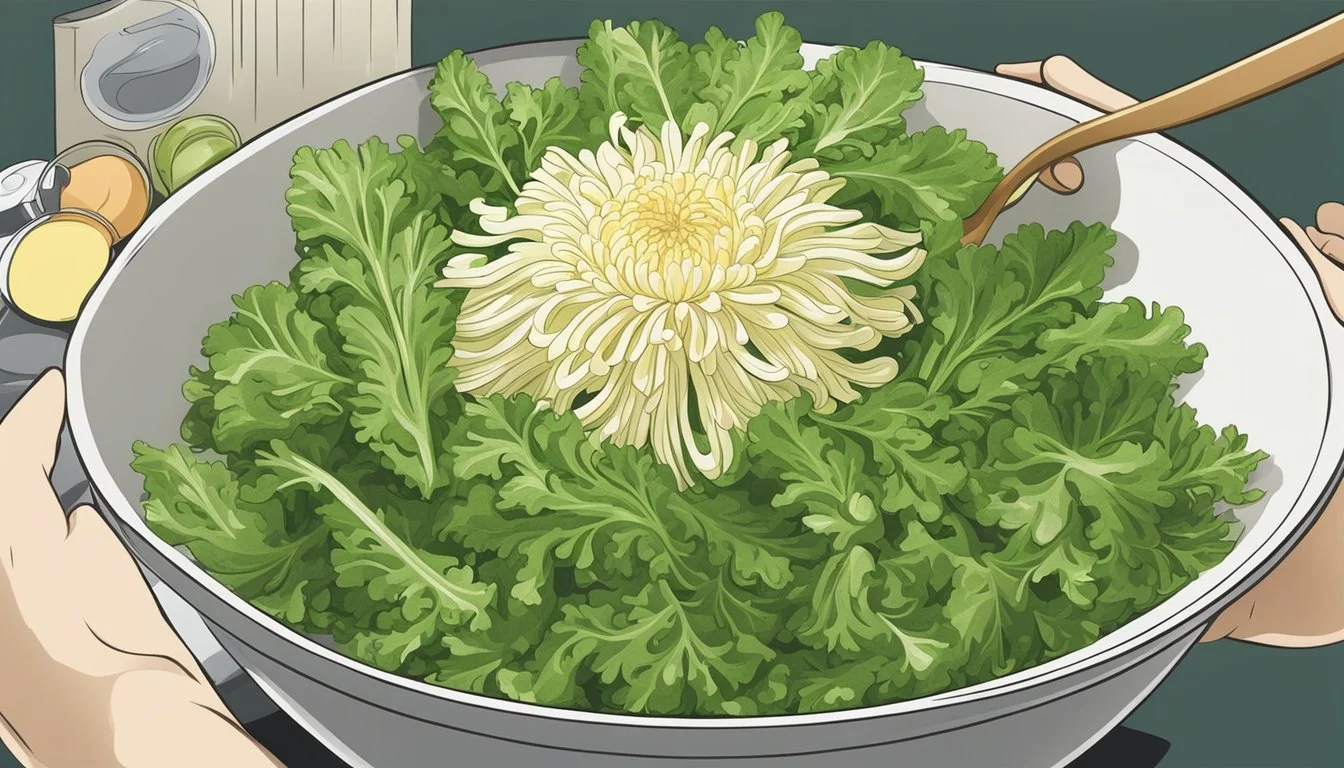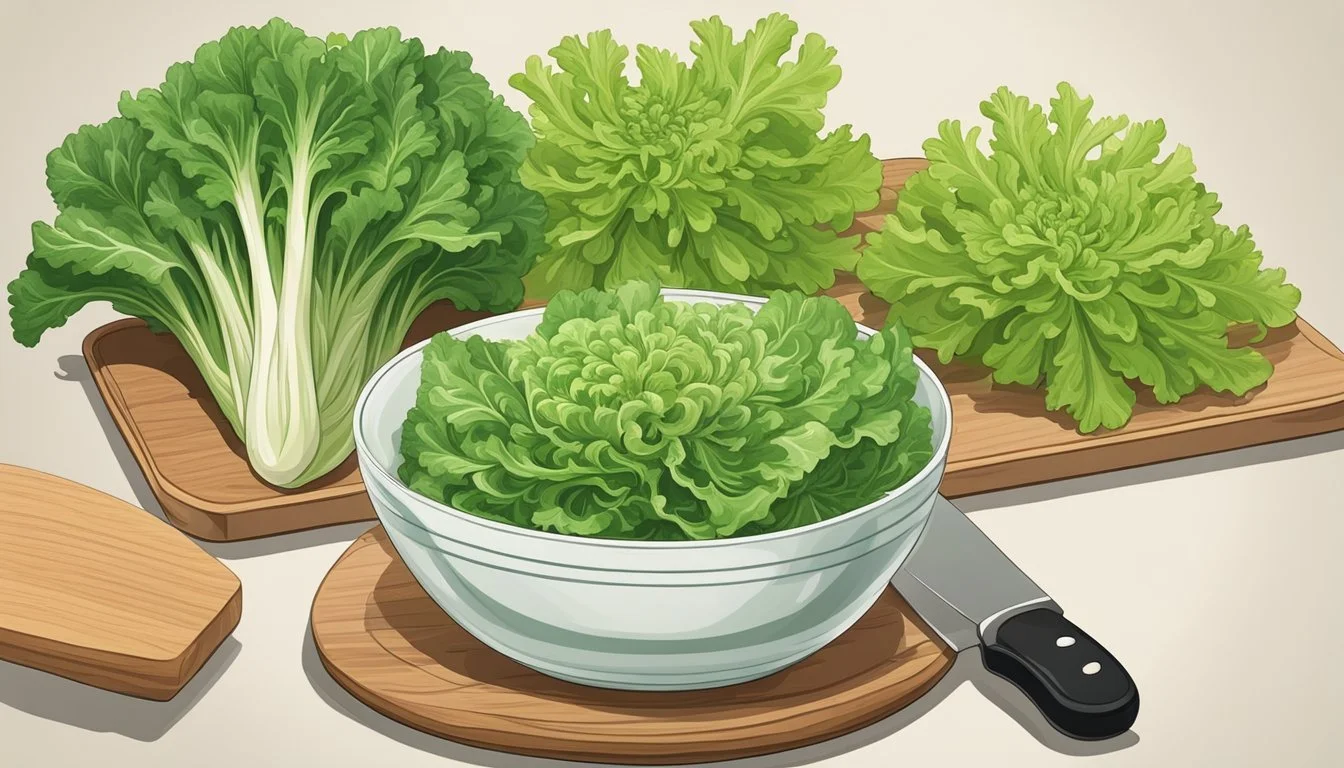How to Substitute Chrysanthemum Greens for Lettuce
A Fresh Salad Twist
Chrysanthemum greens, known in some culinary circles as shungiku, present a unique and flavorful alternative to lettuce in salads (What wine goes well with salads?) and other dishes. Unlike the mild and sometimes bland taste of lettuce, chrysanthemum greens offer a slightly bitter, grassy, and aromatic profile that can elevate the complexity of flavors in simple greens-based meals.
As a versatile ingredient in East Asian cuisine, these greens are not only nutritionally rich but also adaptable to a range of culinary applications. They can be used raw or cooked, broadening their use as a substitution for lettuce. When replacing lettuce with chrysanthemum greens in salads, it's important to consider the intensity of the greens' flavor and to pair them with complementary dressings and ingredients.
Since chrysanthemum greens are more robust and fibrous than lettuce, incorporating them into dishes typically requires a brief blanching process to soften the stems without turning the leaves into a slimy texture. When substituting for lettuce, gentle cooking or even leaving the greens raw can preserve their distinctive texture and taste, ensuring they stand out in salads, wraps, and garnishes while providing an unexpected twist to familiar recipes.
Understanding Chrysanthemum Greens
Chrysanthemum greens, known for their unique flavor and nutritional benefits, are a versatile ingredient in various cuisines, particularly within Asian culinary traditions. This section delves into their botanical characteristics, nutritional value, culinary applications, and distinctive taste.
Botanical Background
Chrysanthemum greens, often referred to as shungiku in Japan, are the leaves of the plant species Chrysanthemum coronarium. They are also known by several other names including crown daisy, garland chrysanthemum, tong ho, and chop suey greens. The greens are herbaceous and are part of the larger Asteraceae family.
Nutritional Profile
The nutritional benefits of chrysanthemum greens are significant; they are a source of fiber, calcium, iron, vitamin C, and potassium. These greens also provide a range of vitamins and are rich in carotene, which is converted into vitamin A in the body, and antioxidants, which protect against cellular damage.
Nutrients in Chrysanthemum Greens:
Fiber: aids in digestion
Calcium: essential for bones and teeth
Iron: critical for blood health
Vitamin C: important for immune defense
Potassium: regulates fluid balance and nerve signals
Antioxidants: combat oxidative stress
Culinary Uses
In the culinary realm, chrysanthemum greens are popular in various cultures, especially in Japanese dishes such as salads, soups, sukiyaki, shabu-shabu, and Japanese hot pot. Their suitability for both raw and cooked applications allows them to provide texture and flavor in diverse culinary preparations.
Flavor Profile
The flavor of chrysanthemum greens is distinctly herbaceous with a peppery and somewhat astringent taste. This complex flavor profile sets them apart from the mildness of lettuce, making them a unique substitute that adds both a nutritional boost and an aromatic, slightly bitter edge to dishes.
Selecting and Preparing Chrysanthemum Greens
When substituting lettuce with Chrysanthemum greens, it is important for one to focus on the greens' unique characteristics: their dark green hue and potential for a crunchy texture. Proper selection, cleaning, and preparation can ensure these greens elevate your dishes with their distinctive flavor.
Purchasing Tips
When looking for Chrysanthemum greens, one should visit Asian markets as they are more likely to carry these greens, especially when they are in season. Select leaves that are vibrant dark green and avoid wilted leaves, which can indicate age and poor quality. The freshness of Chrysanthemum greens is paramount for maintaining their desirable crunchy texture.
Cleaning and Storage
Upon bringing Chrysanthemum greens home, it is advisable to clean them immediately. They should be submerged in cold water to remove any dirt or debris. After cleaning, one must dry the leaves thoroughly to prevent spoilage. For storage, wrap the greens in paper towels and place them in a plastic bag in the refrigerator's crisper drawer to maintain their crispness.
Preparation Techniques
To prepare Chrysanthemum greens, minimal cooking is essential to prevent the greens from becoming too soft. Blanching is a suitable method; one should boil a pot of water, add the greens, and then quickly remove them after no more than 30 seconds. Alternatively, for dishes that require sautéing, a brief exposure to high heat ensures that the greens retain their crunch. Whether one opts for boiling, simmering, or steaming, attention to a swift cooking process is key.
Recipes and Cooking Methods
Chrysanthemum greens, known for their grassy and mildly bitter taste, serve as an excellent substitute for lettuce in various recipes. They add a distinctive aroma and nutritional value to dishes, whether served raw or cooked.
Raw Applications
In raw applications, chrysanthemum greens make an innovative alternative to traditional salad greens. They can be incorporated into salads, offering a unique flavor profile that pairs well with a sesame seed salad dressing. It's essential to tear or cut the leaves into bite-sized pieces for ease of eating.
Spring Salad Recipe:
Combine chrysanthemum greens with other salad favorites such as tomatoes and cucumbers.
Dress the salad lightly with a mixture of olive oil, rice vinegar, toasted sesame seeds, and a splash of soy sauce.
Cooked Dishes
When heated, chrysanthemum greens can be added to soups, stews, and hot pots. They should be added at the end of the cooking process to avoid overcooking, which can make the greens mushy.
Stir-fry Side Dish:
Heat oil in a pan over high heat, quickly stir-fry the greens for a few seconds, then remove from heat.
Sprinkle with a dash of salt or a light soy sauce for flavor.
Cooking Time and Temperature
The cooking time for chrysanthemum greens is notably short. Whether boiling, steaming, or stir-frying, they require no more than 30 seconds to a few minutes of cooking time.
Boiling/Steaming:
Place the greens in boiling water, let them cook for up to 30 seconds, then plunge them into cold water to halt the cooking process.
Hot Pots/Stews:
Add the greens during the last minutes of cooking to maintain their structure and flavor.
Incorporating chrysanthemum greens in place of lettuce can invigorate various recipes with their distinct taste and texture, provided they are not overcooked.
Lettuce Substitutes and Alternatives
When considering the vast array of leafy greens available, it becomes apparent that substituting lettuce is both practical and can enhance a variety of dishes with different textures and flavors.
Occasions to Substitute
Substituting lettuce might be necessary due to dietary preferences, seasonal availability, or simply to introduce a novel taste to traditional dishes. In Japanese cuisine, Chrysanthemum greens (shungiku) are often used in nabemono (one-pot dishes) or nabe (hot pot), contributing a unique and slightly bitter flavor that complements the savory elements of these dishes. Additionally, chrysanthemum greens can offer a refreshing change in salads, bringing a new dimension that lettuce commonly provides.
Ideal Substitutes
It is important to match the texture and flavor of lettuce with suitable alternatives. Here are some ideal substitutes for various types of lettuce:
Spring Mix: A diverse blend including arugula, spinach, and radicchio, offering a balance of peppery and mild flavors.
Kale: Provides a sturdy texture with a slight bitterness, ideal for salads that hold up well when dressed.
Spinach: Delicate in texture with a subtle flavor, works well as a raw or cooked alternative.
Arugula: With its peppery taste, it’s a flavorful stand-in for lettuce in sandwiches and salads.
Iceberg Lettuce: Offers crunchiness and a neutral taste, making it a common substitute.
Cabbage: Can be used shredded for a crisp texture and mild flavor, suitable for both salads and slaws.
Mustard Greens: They have a bold flavor and can be used to spice up salads or sandwiches.
Endive and Frisée: With a slight bitterness, these are good choices for a crunchy and zesty addition to salads.
Radicchio: Its red-purple leaves and slightly bitter taste make it a colorful and flavorful enhancement.
Watercress: With its peppery, fresh flavor, it makes a lively substitute for lettuce in sandwiches and salads.
Dandelion Greens: Their sharp bitterness is best suited for those who enjoy a more robust flavor profile.
Rainbow Chard: The colorful stems add visual appeal to a dish, alongside a flavor that is mild and earthy.
Chrysanthemum greens may be less common but are definitely a worthy substitute, especially for those looking to explore Asian-inspired flavors. They pair exceptionally well with robust or savory dressings and can elevate the taste of traditional green salads.
Dressings and Seasonings
When substituting chrysanthemum greens for lettuce, understanding the unique flavor profile of these greens is essential for pairing with the right dressings and seasonings to enhance their taste.
Home-made Dressing Varieties
Chrysanthemum Greens Vinaigrette:
Ingredients:
3 tablespoons olive oil
1 tablespoon rice vinegar
1 teaspoon mirin
Salt and sugar to taste
Preparation: Combine olive oil, rice vinegar, and mirin in a bowl. Season with a pinch of salt and a small amount of sugar to balance the bitterness of the greens.
Sesame Soy Dressing:
Ingredients:
2 tablespoons sesame oil
1 tablespoon soy sauce
1 teaspoon sugar
Preparation: Whisk together sesame oil, soy sauce, and sugar until the sugar dissolves completely, resulting in a dressing that complements the robust character of the greens.
Seasoning Combinations
For a Simple Season: Blend a pinch of salt and a dash of sesame oil in a mortar and pestle. This combination brings out the inherent nutty flavors of chrysanthemum greens without overpowering them.
For an Asian Twist: Prepare a mix with equal parts of soy sauce and rice vinegar, with a sprinkle of sugar to mellow the flavors. This seasoning merges well with the greens' natural bitterness and adds a layer of complexity.
Health Benefits
Chrysanthemum greens, renowned for their nutritional profile, offer a bountiful supply of essential nutrients. These leafy greens boast a high-density source of vitamins, particularly Vitamin A which supports eye health, and Vitamin C known for its role in immune defense. They also deliver a substantial amount of antioxidants that safeguard the body's cells from oxidative stress.
The greens are a rich source of dietary fiber, which promotes digestive health and may contribute to the control of blood sugar levels. Incorporating them into one's diet can be beneficial for those looking to achieve a balanced digestive routine.
Calcium and iron are minerals significantly present in chrysanthemum greens. Calcium is crucial for maintaining strong bones and teeth, while iron is fundamental for the transportation of oxygen throughout the body.
Nutritional Table
Nutrient Benefit Fiber Aids digestion, regulates blood sugar Calcium Strengthens bones and teeth Iron Essential for oxygen transport Vitamin A Supports eye health Vitamin C Strengthens the immune system Antioxidants Protects cells from oxidative damage
This verdant green offers a compelling choice for those intent on diversifying their diet beyond traditional lettuce. Not only does it enrich meals with a unique flavor profile, but it also enhances the overall nutritional value. When substituting lettuce with chrysanthemum greens, one can feel confident in making a choice that supports their well-being with a blend of important nutrients.
Growing Chrysanthemum Greens at Home
Growing chrysanthemum greens, also known as Shungiku, can be a rewarding endeavor for the home gardener. These greens, characterized by their grassy and mildly bitter flavor, require specific conditions to thrive.
Sunlight and Placement
Chrysanthemum greens flourish under full sunlight but can tolerate partial shade. Gardeners should allocate a spot where the plants can receive at least six hours of sunlight daily.
Soil Requirements
These greens prefer well-draining soil with a neutral to slightly acidic pH. Enriching the soil with organic compost can provide the necessary nutrients for healthy growth.
Watering Schedule
Consistent moisture is key, yet the soil should not become waterlogged. It is advisable to provide moderate but regular watering, allowing the soil to dry slightly between each session.
Planting and Care
Seed Sowing: Sow the seeds about 1/4 inch deep in soil and space them a few inches apart. As they grow, thin the seedlings to prevent overcrowding.
Harvesting Method: One may employ a cut-and-come-again approach, beginning 4-5 weeks after sowing when plants are 2-4 inches tall, or harvest the entire plant after 6-8 weeks, once it reaches 5-10 inches.
To ensure the plants develop properly, they should be monitored for pests and diseases regularly. Gardeners are encouraged to start with quality seeds and maintain consistent care to enjoy a bountiful harvest of chrysanthemum greens.
Conclusion
Substitutes for lettuce in salads can vary widely depending on texture, flavor, and nutritional profile preferences. Chrysanthemum greens, with their distinct aromatic edge, offer an excellent alternative. One should be mindful of their cooking times as they quickly become overcooked. Briefly blanched or raw, they contribute a mildly bitter tang and a nutritive boost to any salad.
Incorporating fruits and vegetables can reduce reliance on leafy greens alone, creating a complex and nutritious salad. Chrysanthemum greens' unique flavor pairs well with an array of ingredients, from the crunchy water chestnuts to the sweetness of fresh blueberries.
When replacing lettuce, remember these key points:
Flavor: Chrysanthemum greens are more bitter and grassy than lettuce.
Texture: They should remain crisp, so minimize cooking time.
Nutrition: Chrysanthemum greens offer vitamins and minerals potentially more abundant than those in various lettuce varieties.
For those looking to diversify their salad greens, shungiku or chrysanthemum greens can be an acquired taste. Yet, their culinary versatility extends to soups, stews, and hot pots, illustrating their robustness as a lettuce substitute. Whether seeking variety, flavor enhancement, or nutritional augmentation, they are a viable and vibrant component for any culinary creator's repertoire.
Additional Resources
Exploring the ample world of culinary substitution can often lead to new discoveries and improved techniques. For those looking to substitute chrysanthemum greens for lettuce, additional resources can be found in online communities and specialized cookbooks or guides that are rich with informed advice and recipes.
Online Communities
Online communities serve as excellent platforms for exchanging ideas and getting advice on ingredient substitutions. Facebook groups dedicated to Japanese cooking can be a source of guidance and inspiration, where members often share personal experiences and tips. On Pinterest, one can find a variety of recipe pins and infographics regarding chrysanthemum greens, offering visual guides and alternative uses.
For video tutorials, YouTube hosts numerous channels focused on Japanese cuisine, where chefs often demonstrate the preparation of dishes using chrysanthemum greens in place of lettuce. Additionally, Instagram is a treasure trove for real-time cooking demonstrations and before-and-after photos from experienced cooks who often include recipes and substitution tips in their posts.
Cookbooks and Guides
Cookbooks specifically devoted to Japanese cooking are invaluable for learning to substitute chrysanthemum greens for lettuce. These texts often provide detailed instructions and flavor profiles, which are crucial for successful substitutions.
Guides may come in the form of a free email series or a weekly newsletter, offering structured learning about Japanese cooking tips and in-depth advice on using chrysanthemum greens. These resources are typically compiled by experienced cooks or chefs, ensuring the reader receives knowledgeable insights into the culinary world of Japanese greens.







